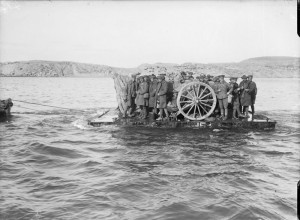
25th April is ANZAC Day which marks the start of the disastrous invasion of the Dardanelles, usually known as Gallipolli. In this centenary year it is being used here and in Australia and New Zealand to celebrate the re-writing of history and to promote new wars. As with all aspects of World War 1 it is important to remember what really happened.
You would think from most of the current stories in the media that it was a famous victory and that the participants were overwhelmingly Australian and New Zealand troops. Needless to say the real story is rather different.
This invasion of Turkey was caried out to further Britain’s war aims in the Middle East and to protect British interests in the area and further afield in India.
One of the main instigators of the disastrous plans was Winston Churchill. The whole scheme was based on racist assumptions about the inability and unwillingness of Turks to fight off any invasion.
From the first landings in April 1915 to the withdrawal of the invading armies in December 1915 and January 1916, the territory gained could be measured in hundreds of yards. The invading troops spent most of the months on or near the beaches on which they landed. In the case of the first Australian troops this was even the wrong beach!
At the end of the campaign over 86,000 Turks were dead, over 21,000 British troops, over 10,000 French troops, over 8,000 Australians and over 2000 New Zealanders, including many Maoris. Tens of thousands more were wounded on all sides. Soldiers of the Indian Army also fought there.
The survivors were all sent on the the Western front where many more of them died.
And of course the rulers of the Ottoman Empire were undertaking the massacre of the Armenians at the same time – 1.5 million people were killed.
A battalion of the Gloucestershire Regiment was sent to Gallipolli in July 1915. Over 300 of them were killed including many from Bristol. 180 of these men died on one day in August 1915. Bristol men serving in other regiments also fought and died there.
The myth is that Gallipolli forged the Australian nation. This a contested myth. Germaine Greer recently wrote this article in the New Statesman. This article by David Rowlands deals with the same myth, linking it to the genocide against the Armenians.
Some other useful resources to help in learning more about Gallipolli are:
- A short Australian film explaining some of the facts about Gallipolli – here.
- An episode of the 1960’s BBC series World At War – here
- A film made by Australian TV for the 90th anniversary, including interviews with veterans – here.
- An article about the Armenian genocide – here.
- More about the Armenian genocide – here.
Eric Bogle, wrote the classic song ‘The Band Played Walzing Matilda’ about the invasion. Hear it here sung by the Pogues, here by June Tabor and here by Eric Bogle himself. Read an interview with Eric Bogle here.